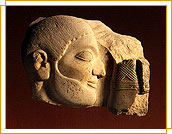Theagenes of Thasos (pankration, boxing)
Theagenes, son of Timosthenes a priest at the temple of Herakles in Thasos, developed into one of the most famous pankratiasts, and after his death he was worshipped as a god-healer.  Some believed that in reality he was the son of a god, who disguised slept with his mother. Some believed that in reality he was the son of a god, who disguised slept with his mother.
Theagenes became famous when he was nine years old. Then, it is said, that he stole the bronze statue of a god and carried it to his home. Some people in Thasos were furious for this sacrilegious act and wanted to punish him with the penalty of death. But finally it was decided that carrying the statue back to its place was punishment enough, and Theagenes did that. The story of this achievement made him famous all over Greece.
The young man from Thasos became an Olympic victor for the first time in 480 BC (75th Olympiad) in boxing and in 476 BC (76th Olympiad) in pankration. In addition, he won three times in the Pythian games, nine times in the Nemean and ten times in the Isthmian, sometimes in boxing and sometimes in pankration. At one time, in the games organized in Phthia in honor of Achilles, he tried the dolichos, one of the running events and he emerged victorious. According to the ancient sources, the wreaths he won during his athletic career were 1,400. Pausanias mentioned that his statue in Olympia, the work of the sculptor Glaukias from Aigina, was set in the Altis next to the ones of Philip II and his son Alexander the Great.
Theagenes became quite famous in his country and his compatriots were very proud of him. After his death, they set up his statue in Thasos. Pausanias narrated a relevant story, when someone who was an opponent of Theagenes, but never managed to defeat him while he was alive, whipped the statue of the Olympic victor every night. It appears that one night, while he was whipping the statue, it fell on him and killed him. His children, overwhelmed with grief, accused the statue of murder. According to the laws of Thasos, murder was punished by exile, and subsequently the statue was thrown in the sea. Following this, a severe drought broke on the island. Obeying an oracle from Delphi, in an effort to appease Demeter, the people of Thasos recalled all the people exiled. However, the drought and pestilence continued and the rulers asked again the help of the oracle. Then Pythia reminded them of Theagenes' statue, which lay at the bottom of the sea. And while they were considering how to find the statue, some fishermen caught it in their nets and brought it ashore. The drought stopped and since then the people of Thasos began offering sacrifices to Theagenes, the god-healer.
|
